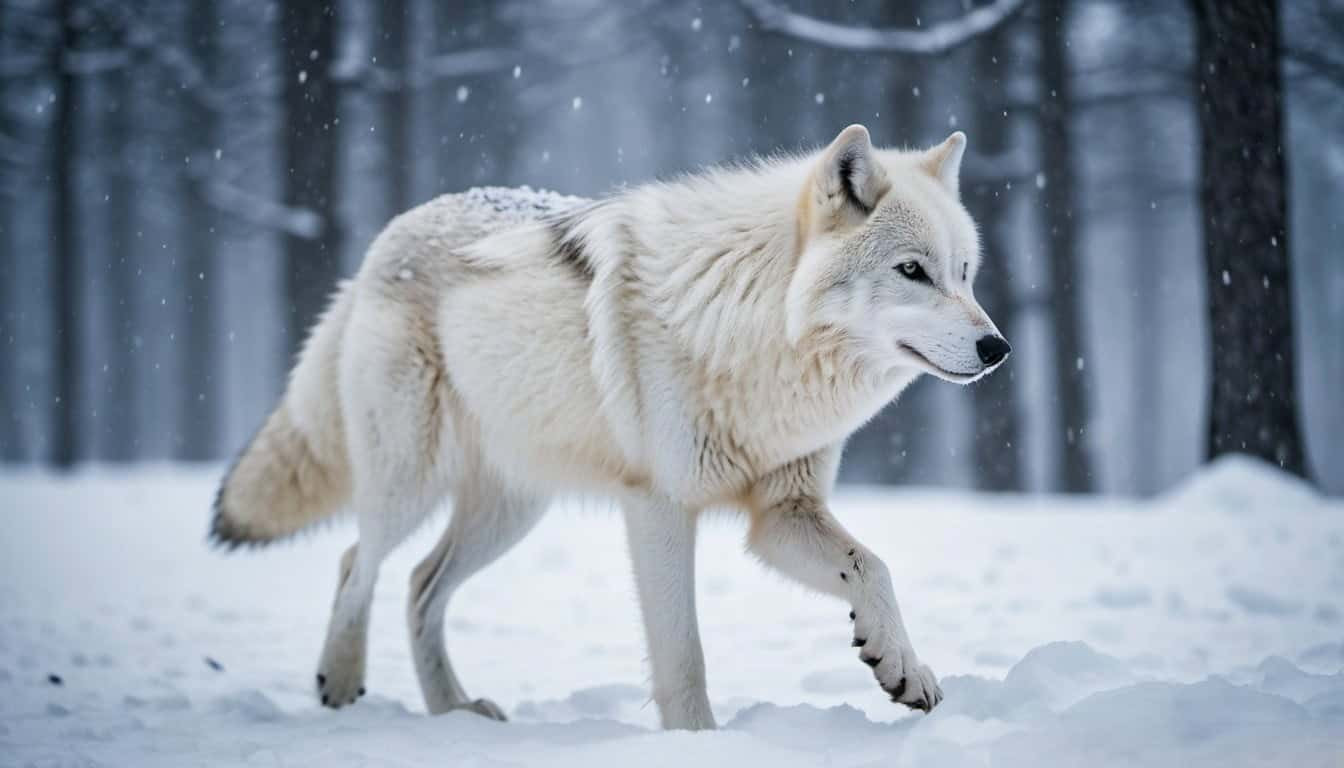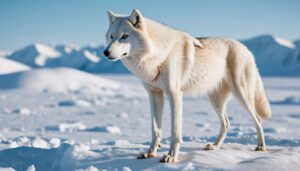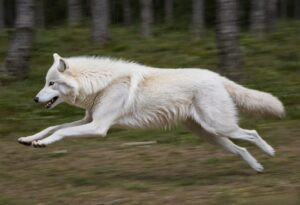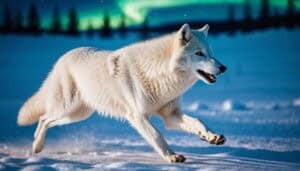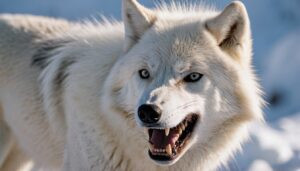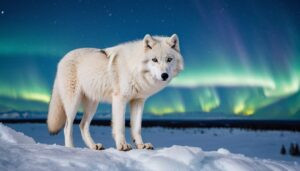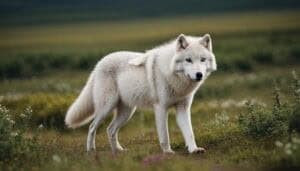Introduction
Understanding how Arctic wolves’ skeletal adaptations aid in hunting provides insights into their survival in one of the planet’s harshest environments
This article delves into the specific skeletal features that enhance their hunting abilities, compares these adaptations with other wolves, and explores the evolutionary reasons behind these changes. By examining these aspects, we can appreciate the intricate design that enables Arctic wolves to thrive in extreme conditions
Key Skeletal Features of Arctic Wolves
Arctic wolves, known for their resilience and adaptability, have developed several skeletal features that significantly aid in their hunting capabilities. These adaptations are crucial for their survival in the frigid and unforgiving Arctic environment
The Strong Legs of Arctic Wolves
One of the most notable skeletal adaptations of Arctic wolves is their strong, muscular legs. These legs are not only powerful but also long, providing several advantages during hunting:
Enhanced Speed and Agility: The strong leg muscles enable Arctic wolves to run at high speeds, essential for chasing down agile prey such as caribou and Arctic hares. Their long strides allow them to cover significant ground quickly, reducing the chances of prey escape
Endurance in Harsh Conditions: The strength of their legs also contributes to their endurance, allowing them to travel long distances across the snow-covered tundra in search of food. This endurance is crucial in an environment where prey can be scarce and widely dispersed
Leaping Capability: Strong legs give Arctic wolves the ability to leap over obstacles and navigate through deep snow. This agility is essential when stalking prey or evading potential threats
Importance of Large Paws in Snowy Environments
Another critical skeletal adaptation is the large paws of Arctic wolves. These paws are designed to support their weight and facilitate movement in their icy habitat:
Snowshoe Effect: The large surface area of their paws acts like snowshoes, distributing their weight more evenly and preventing them from sinking into the snow. This adaptation allows them to move swiftly and stealthily while hunting
Traction and Stability: The paws are also equipped with rough pads and sharp claws that provide excellent traction on icy surfaces. This grip is essential for maintaining stability while running and making sharp turns during a chase
Heat Retention: The large paws help in minimizing heat loss. The fur covering their paws provides insulation against the cold ground, helping to keep their extremities warm in freezing temperatures
The Role of Powerful Jaws in Hunting
Arctic wolves possess powerful jaws that are essential for capturing and processing prey:
Strong Bite Force: The robust jaw muscles and large skull enable Arctic wolves to exert a strong bite force, which is crucial for taking down large prey such as muskoxen and deer. This powerful bite allows them to hold onto struggling prey and deliver fatal bites to vital areas
Teeth Adaptations: Their teeth are adapted for a carnivorous diet, with sharp canines for puncturing and holding prey and carnassial teeth for shearing flesh. This dental structure ensures they can efficiently consume the meat and bones of their kills
Feeding Efficiency: The powerful jaws and specialized teeth enable Arctic wolves to quickly and efficiently process their food, which is vital in an environment where scavengers and harsh weather can threaten their meals
The Spine and Its Role in Hunting Efficiency
The flexibility and strength of the spine are also crucial for the hunting prowess of Arctic wolves:
Flexibility for Agile Movements: The spine of an Arctic wolf is both flexible and strong, allowing for a wide range of motion. This flexibility aids in executing sharp turns and sudden movements during a hunt, making them agile predators
Support for Strong Legs: The spine provides the necessary support and stability for the powerful leg muscles, ensuring that the wolf can maintain balance and coordination while running at high speeds or leaping across rough terrain
Shock Absorption: The vertebral structure helps in absorbing the impact during high-speed chases and jumps, protecting vital organs and preventing injuries
These skeletal adaptations collectively enhance the hunting capabilities of Arctic wolves, enabling them to thrive in the harsh Arctic environment. The combination of strong legs, large paws, powerful jaws, and a flexible spine allows them to be efficient and formidable hunters
Comparison with Other Wolves
Arctic wolves exhibit several unique skeletal adaptations that set them apart from other wolf species. These differences are a direct result of their specific environmental needs and the challenges they face in the Arctic region
Differences in Skeletal Adaptations
While all wolves share a common ancestry and many skeletal similarities, Arctic wolves have evolved distinct traits to thrive in their icy habitats:
Size and Robustness: Arctic wolves tend to be stockier and more robust compared to other wolves like the gray wolf. This body structure is an adaptation to conserve heat and endure the harsh Arctic climate. The shorter limbs and more compact bodies help minimize heat loss
Paw Structure: The paws of Arctic wolves are significantly larger and furrier compared to those of other wolves. This difference is crucial for moving through deep snow and provides better insulation against the cold
In contrast, wolves in temperate regions have less fur on their paws and smaller pads adapted for mixed terrains rather than constant snow
Leg Strength and Endurance: While all wolves possess strong legs, Arctic wolves have exceptionally muscular legs adapted for long-distance travel in search of scarce prey
This adaptation contrasts with wolves in more temperate regions, where prey is more abundant, and long-distance travel is less critical.
Jaw Strength and Dentition: Arctic wolves have slightly more robust jaws and a dental structure that allows them to process tougher and more fibrous prey, such as muskoxen and caribou. This adaptation is less pronounced in wolves that hunt smaller or softer prey
Behavioral and Habitat Considerations
The skeletal differences between Arctic wolves and other wolf species are not solely physical but also reflect their differing behaviors and habitats:
Hunting Strategies: Arctic wolves often hunt in packs to take down large prey. Their skeletal adaptations, including strong legs and jaws, support this collaborative hunting strategy
In contrast, wolves in other regions might rely more on solo or smaller group hunts, targeting smaller prey that doesn’t require as robust skeletal features
Habitat Adaptations: The skeletal structure of Arctic wolves is designed to withstand the extreme cold and treacherous terrain of the Arctic. In comparison, wolves in forests or plains have adapted to different environmental challenges, resulting in variations in their skeletal features
Survival Mechanisms: The overall robustness of Arctic wolves helps them survive long periods without food, relying on fat reserves and a sturdy frame to endure the harsh conditions
This contrasts with wolves in more temperate regions, where food sources are more consistent, and such extreme adaptations are unnecessary
Evolutionary Divergence
The evolutionary divergence between Arctic wolves and other wolf species highlights how environmental pressures shape skeletal adaptations:
Natural Selection: Over thousands of years, natural selection has favored Arctic wolves with traits that enhance their survival in the Arctic. This process has led to the development of stronger legs, larger paws, and powerful jaws, setting them apart from their relatives in more temperate climates
Genetic Variations: Genetic mutations that provided advantages in the Arctic environment became more prevalent in the population, leading to a distinct set of skeletal characteristics. These variations are less common in wolves living in different environments
Adaptive Radiation: The concept of adaptive radiation explains how different populations of the same species adapt to diverse environments. In the case of Arctic wolves, their adaptations are a classic example of how a species evolves distinct traits to survive in a unique habitat
Understanding these differences between Arctic wolves and other wolf species sheds light on the remarkable adaptability of wolves as a species. It highlights the critical role of skeletal adaptations in enabling Arctic wolves to hunt effectively and thrive in one of the planet’s most challenging environments
Survival in Harsh Conditions
Arctic wolves face some of the most extreme environmental conditions on Earth. Their skeletal adaptations are crucial not only for hunting but also for surviving in these harsh climates
These adaptations enable them to endure frigid temperatures, scarcity of food, and the physical demands of their environment
Adaptations for Extreme Cold
Arctic wolves are uniquely adapted to withstand the severe cold and harsh weather of the Arctic region. These adaptations are evident in their skeletal structure and overall physiology:
Insulated Fur and Compact Body: While not a skeletal feature, the dense, insulating fur of Arctic wolves is complemented by their more compact skeletal structure. This combination minimizes heat loss and maximizes heat retention, critical for survival in sub-zero temperatures
Shorter Limbs: Compared to other wolves, Arctic wolves have shorter limbs, which reduces the surface area exposed to the cold. This adaptation helps conserve body heat and allows them to maintain a stable core temperature even in icy conditions
Nasal Structure: The nasal cavity of Arctic wolves is adapted to warm the cold air before it reaches their lungs. While this is more of a physiological adaptation, the structure of their nasal bones supports this function, helping to prevent heat loss during respiration
Reasons Behind Skeletal Adaptations
The specific skeletal adaptations of Arctic wolves are the result of thousands of years of evolution. These adaptations have been honed to improve their chances of survival in the Arctic:
Natural Selection: Over generations, Arctic wolves with skeletal features that enhanced their ability to hunt, travel, and withstand the cold were more likely to survive and reproduce. This process of natural selection has led to the development of traits that are perfectly suited for the Arctic environment
Environmental Pressures: The extreme conditions of the Arctic exert significant pressure on its inhabitants. Wolves that could not cope with the cold or the scarcity of food were less likely to survive. As a result, only those with the best-suited skeletal adaptations thrived and passed on their genes
Evolutionary Advantage: Each skeletal adaptation provides a specific advantage that contributes to the wolf’s overall fitness. For example, strong legs enable long-distance travel in search of food, large paws prevent sinking into snow, and powerful jaws ensure that they can capture and consume a wide range of prey
The Role of Behavioral Adaptations
Skeletal adaptations are closely linked with the behavioral strategies that Arctic wolves employ to survive:
Pack Hunting: Arctic wolves often hunt in packs, a behavior supported by their strong, muscular legs and powerful jaws. This cooperative hunting strategy increases their chances of taking down large prey and ensures that all pack members are fed
Territorial Range: The vast territories that Arctic wolves cover require endurance and strength. Their skeletal structure, particularly their legs and paws, enables them to travel long distances across challenging terrain to patrol their territory and find food
Denning Behavior: Arctic wolves dig dens in the snow or ground to shelter from the cold. Their strong limbs and sturdy skeletal frame facilitate this behavior, providing a safe and warm environment for raising their young
Adaptations to Food Scarcity
Food scarcity is a common challenge in the Arctic, and Arctic wolves have adapted their hunting strategies and skeletal features to cope with this:
Efficient Hunting: Their powerful jaws and sharp teeth allow them to make the most of each kill, consuming nearly all parts of their prey, including bones. This efficiency is crucial when food is not readily available
Fat Storage: During times of abundance, Arctic wolves build up fat reserves. Their robust skeletal structure supports these fat deposits, which provide energy during periods of scarcity
Scavenging: In addition to hunting, Arctic wolves are opportunistic scavengers. Their strong legs and powerful jaws enable them to defend carcasses from other predators and extract maximum nutrition from the remains
The skeletal adaptations of Arctic wolves are a testament to their resilience and ability to thrive in one of the harshest environments on Earth. These adaptations, combined with their behavioral strategies, ensure that they can not only survive but also successfully hunt and raise their young in the Arctic
Enhancement of Speed and Agility
Arctic wolves are known for their speed and agility, which are essential for hunting in the vast and treacherous Arctic environment. Their skeletal structure plays a crucial role in enhancing these abilities, enabling them to pursue and capture prey effectively
Skeletal Features for Fast Movement
The skeletal adaptations of Arctic wolves are specifically designed to support fast and efficient movement across the Arctic tundra:
Muscular and Strong Legs: The powerful leg muscles of Arctic wolves are supported by sturdy bones, providing the strength needed for high-speed chases. These muscular legs allow them to sprint quickly to catch swift prey, such as Arctic hares and caribou
Flexible Joints: The joints of Arctic wolves are highly flexible, allowing for a wide range of motion. This flexibility is crucial for making sudden turns and rapid directional changes during a hunt, increasing their chances of catching agile prey
Elongated Limbs: Although Arctic wolves have shorter limbs compared to some other wolf species, their legs are still elongated enough to facilitate long strides. This adaptation enables them to cover more ground with each step, contributing to their overall speed
How Skeletal Adaptations Aid in Hunting
The skeletal adaptations of Arctic wolves are not just about speed; they also enhance their overall hunting strategy by providing agility and endurance:
Balance and Coordination: The skeletal structure of Arctic wolves, including their spine and limbs, is designed to provide excellent balance and coordination. This is vital when navigating the uneven and slippery terrain of the Arctic, allowing them to maintain stability while pursuing prey
Efficient Energy Use: The streamlined skeletal frame of Arctic wolves ensures that their movements are energy-efficient. This efficiency is essential for maintaining high speeds over long distances without exhausting their energy reserves
Quick Recovery: The robust skeletal structure, particularly the spine and leg bones, helps absorb the impact of high-speed chases and jumps. This ability to withstand physical stress and quickly recover is crucial for repeated hunting efforts
Role of the Spine in Speed and Agility
The spine of Arctic wolves is a key component in their ability to move quickly and agilely:
Flexible Vertebrae: The vertebrae of Arctic wolves are flexible yet strong, allowing for a high degree of movement. This flexibility is essential for bending and twisting their bodies during high-speed pursuits
Shock Absorption: The spine acts as a shock absorber, reducing the impact of each stride and leap. This feature protects the wolf’s internal organs and reduces the risk of injury during intense hunts
Support for Powerful Muscles: The spine provides the necessary support for the powerful back and leg muscles, enabling efficient transfer of energy from muscle contractions to movement. This support enhances both speed and agility
Coordination Between Skeletal and Muscular Systems
The coordination between the skeletal and muscular systems of Arctic wolves is a key factor in their hunting success:
Synchronized Movements: The skeletal and muscular systems work in harmony to produce smooth and synchronized movements. This coordination is crucial for executing complex hunting maneuvers and maintaining speed during long chases
Strength and Endurance: The combination of strong bones and muscles ensures that Arctic wolves can maintain high speeds for extended periods. This endurance is necessary for chasing down prey that may try to outrun them over long distances
Agile Pouncing: When it comes to the final capture, Arctic wolves rely on their agility to pounce accurately on their prey. The skeletal adaptations, including strong and flexible legs, allow for precise and powerful leaps, ensuring a successful capture
The speed and agility of Arctic wolves are a result of their specialized skeletal adaptations. These features, combined with their muscular strength and coordination, make them formidable hunters in the challenging Arctic environment
By understanding these adaptations, we can appreciate the remarkable evolutionary design that enables Arctic wolves to thrive as top predators in their icy domain
Conclusion
Arctic wolves are remarkable creatures, perfectly adapted to their harsh and unforgiving environment. Their skeletal adaptations play a crucial role in their ability to hunt, survive, and thrive in the Arctic. By examining these adaptations, we gain a deeper understanding of their unique capabilities
Key Skeletal Features of Arctic Wolves such as strong legs, large paws, and powerful jaws enable them to move efficiently, capture prey, and process their food effectively. Their spinal flexibility further enhances their hunting prowess by providing the necessary support for agile and fast movements
When we compare Arctic wolves with other wolves, we see distinct differences in skeletal structure that highlight their specialized adaptations for the Arctic. These differences are not just physical but also reflect their unique behavioral strategies and environmental needs
Survival in such an extreme environment requires more than just hunting skills. Arctic wolves’ adaptations for extreme cold and their ability to endure food scarcity are vital for their overall survival. These adaptations, coupled with their ability to cover vast territories, show how their skeletal structure is intricately linked to their survival strategies
The enhancement of speed and agility through skeletal adaptations allows Arctic wolves to be efficient hunters. Their skeletal and muscular systems work in perfect harmony, enabling them to pursue and capture prey with precision and endurance
Overall, the skeletal adaptations of Arctic wolves are a testament to the power of evolution and natural selection. These adaptations ensure that Arctic wolves remain apex predators in one of the most challenging environments on Earth. By understanding these features, we appreciate the incredible resilience and adaptability of Arctic wolves, marveling at how they continue to thrive against the odds
